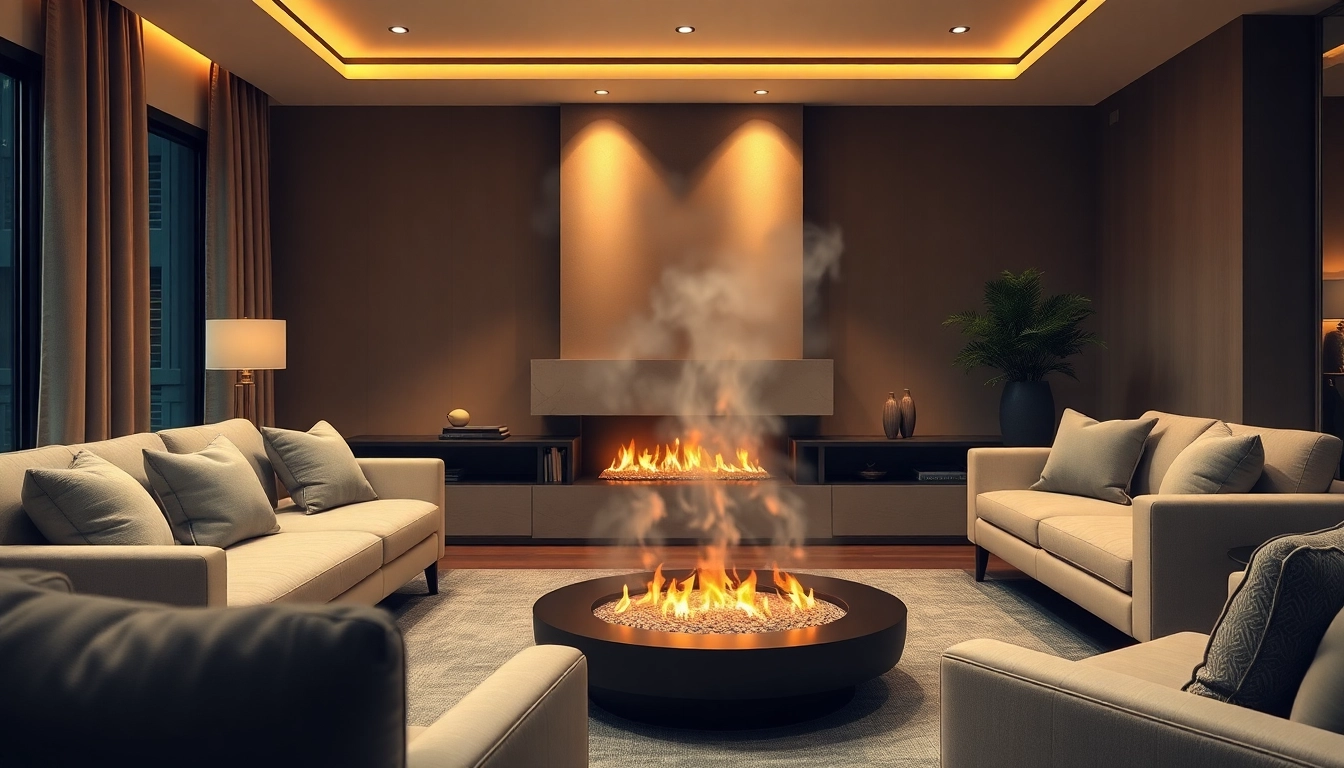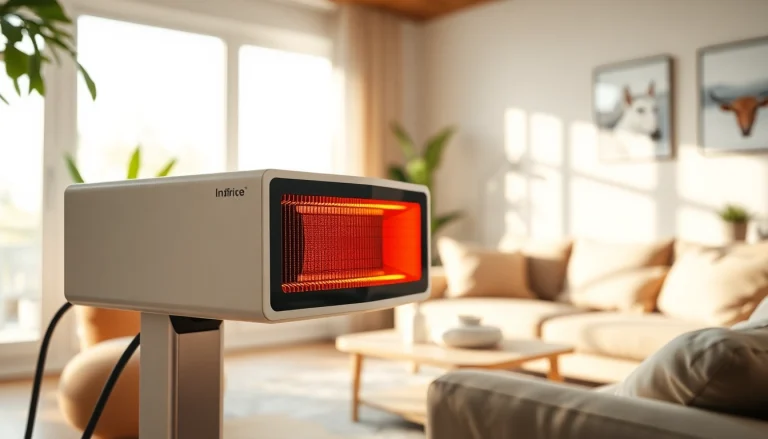Understanding Water Vapor Fireplaces
What is a Water Vapor Fireplace?
A water vapor fireplace is a relatively new and innovative electric fireplace that utilizes ultrasonic technology to produce a mesmerizing and realistic flame effect. Unlike traditional fireplaces that burn wood or gas, water vapor fireplaces create the illusion of flames through the combination of water vapor and colorful LED lights. This technology allows for a captivating ambiance without the inherent dangers of an open flame.
Water vapor fireplaces are designed not only for aesthetic appeal but also for safety and efficiency. They use a method called the Opti-Myst technology, which creates a 3D-like flame effect by vaporizing water, subsequently illuminated by powerful LED lights. This results in a safe, cool-to-the-touch environment that is ideal for homes with children or pets.
How Does It Work?
The operation of a water vapor fireplace is straightforward yet fascinating. When the system is activated, an ultrasonic transducer generates high-frequency vibrations that turn water in the reservoir into a fine mist. This water vapor is then illuminated by LED lights, creating a flickering effect that resembles a natural flame.
The control systems typically integrate smart technology, allowing users to adjust the flame’s color and intensity. Many models can be operated via remote control or even smartphone applications, enabling convenience and customization to fit various moods.
Types of Water Vapor Fireplaces
Water vapor fireplaces come in various designs and models to cater to different preferences and spaces. The main types include:
- Wall-Mounted Fireplaces: These units fit seamlessly into the wall, making them perfect for saving space while still providing a striking focal point.
- Freestanding Units: These fires can be moved easily, allowing flexibility in placement and design. They often come in various styles to match home decor.
- Insert Models: Designed to be added into existing fireplaces, these models use the existing structure to house the electric components, creating a beautiful environment without the need for extensive renovations.
Benefits of Choosing Water Vapor Fireplaces
Safety Features for Families
One of the most significant advantages of water vapor fireplaces is their safety features. Since they do not generate real flames, the risk of fire hazards is greatly reduced. This makes them ideal for family homes where children and pets are present. In addition, these fireplaces emit no harmful fumes or chemicals, contributing to cleaner indoor air quality.
For families who wish to enjoy the ambiance of a fire without the associated risks, a water vapor fireplace provides a compelling solution. Furthermore, the units often come with safety sensors to prevent overheating and automatically shut off in case of low water levels, enhancing overall security.
Environmental Impact and Energy Efficiency
In our environmentally conscious era, the ecological benefits of water vapor fireplaces stand out. They operate primarily on electricity, reducing reliance on fossil fuels. The absence of emissions means they do not contribute to air pollution, making them a more sustainable choice compared to traditional fireplaces. Additionally, they utilize less energy compared to conventional heating methods, providing an economical option for heating your home.
Many water vapor fireplaces also feature energy-efficient settings that allow users to optimize energy usage. This is particularly beneficial during colder months when heating needs can increase. Utilizing these settings can lead to significant energy savings, lowering both the environmental footprint and utility bills.
Year-Round Aesthetic Appeal
Water vapor fireplaces provide aesthetics that can enhance the beauty and vibe of any space. With their realistic flame effect, they can elevate interiors—from modern minimalist designs to rustic farmhouse settings. They serve as an excellent decorative element throughout the year, ensuring your home maintains a warm and inviting ambient atmosphere.
In the summer months, when traditional fireplaces are seldom used, a water vapor fireplace can still be an eye-catching feature, providing a tranquil flame effect without the heat. This versatility makes them a favored option among homeowners and designers alike.
Installation and Maintenance of Water Vapor Fireplaces
Installation Options and Considerations
Installing a water vapor fireplace can be a relatively simple process, especially compared to traditional alternatives. Depending on the model, installation can often be a DIY project; however, having a professional can ensure proper placement and connection. It is crucial to consider the power source and water supply if a direct line is desired. If a reservoir is used, it must be checked regularly for refills.
When choosing a location for your water vapor fireplace, consider factors like aesthetics, accessibility, and power supply. Wall-mounted units should be placed at an appropriate height, while freestanding models can be positioned according to user preference and space constraints.
Regular Maintenance Tips
Maintenance of water vapor fireplaces is essential for optimal performance. While they are generally low maintenance, here are some practical tips:
- Regular Cleaning: Clean the misting system and the water reservoir every few weeks to prevent mineral buildup, especially if you use tap water.
- Check the Mist Output: Ensure that the mist output is consistent. If it becomes weak, this might indicate that the components require cleaning.
- LED Light Checks: Regularly check the LED lights for functionality as they are critical for creating the flame illusion.
Common Issues and Troubleshooting
While water vapor fireplaces are generally reliable, users may encounter some common issues, such as:
- Weak Mist Output: This could be due to mineral buildup in the ultrasonic transducer. Regular maintenance and using distilled water can help mitigate this problem.
- Flame Illusion Failure: If the LED lights are not functioning correctly, the flame effect may diminish. Check connections and replace bulbs as necessary.
Having a troubleshooting guide from the manufacturer can help resolve minor issues quickly without the need for professional assistance.
Comparing Water Vapor Fireplaces to Traditional Options
Heat Output and Energy Consumption
Traditional fireplaces are known for providing substantial warmth, especially during the winter months. However, this often comes at the cost of increased energy consumption and emissions. In contrast, water vapor fireplaces do not generate heat but provide a comforting visual experience. They utilize less power, making them an energy-efficient alternative for ambiance without excessive heating.
For homeowners who desire the charm of flames without the heating power, especially in summer months, water vapor fireplaces make perfect sense. Their versatility allows for year-round enjoyment without the disadvantage of overheating a room.
Aesthetic Differences
The aesthetic appeal of water vapor fireplaces differs significantly from traditional fireplaces. While wood or gas fireplaces offer a classic, rustic feel, water vapor fireplaces boast modern technology with sleek, contemporary designs. They can simulate flames in various colors and often feature customizable settings that allow the user to set the perfect ambiance.
In terms of integration with modern decor styles, water vapor fireplaces provide abundant styling options that can harmonize with virtually any interior structure, enabling a seamless blend of form and function.
Cost Analysis and Value for Money
When considering the financial aspect, the initial investment in a water vapor fireplace might be higher compared to traditional units; however, the lack of extensive installation and ongoing maintenance costs may offset this. Over time, their energy efficiency contributes to reducing electricity bills, providing significant savings.
The unique features of water vapor fireplaces, such as customizable ambiance and enhanced safety, may yield long-term value that surpasses traditional alternatives.
Choosing the Right Water Vapor Fireplace for Your Home
Factors to Consider Before Purchase
Before making a purchase decision, several factors should be considered:
- Size and Space: Ensure the model you choose fits your designated space without overwhelming the room.
- Design and Style: Select a style that complements your home decor. From minimalist to ornate, there are many options available.
- Feature Set: Evaluate the additional features, such as remote controls and color adjustments, to determine what best suits your lifestyle.
Top Brands and Models
Several brands are leading the market for water vapor fireplaces, each offering unique models with different specifications. The Aquafire line is noted for its advanced technology and user-friendly designs, while Dimplex is recognized for its reliable quality and variety of styles. It’s advisable to read consumer reviews and compare specifications to choose a trusted brand that meets your preferences.
Maximizing Your Investment
To maximize your investment in a water vapor fireplace, consider the following strategies:
- Proper Installation: Professional setup can ensure quality performance and prevent issues.
- Regular Maintenance: Follow maintenance routines to keep the unit functioning efficiently.
- Utilization for Aesthetics: Take advantage of the fireplace’s aesthetic appeal by utilizing it year-round for gatherings and decor.
Investing in a water vapor fireplace not only elevates the ambiance of your space but also provides long-term practical benefits, making it an attractive option for modern homes.








